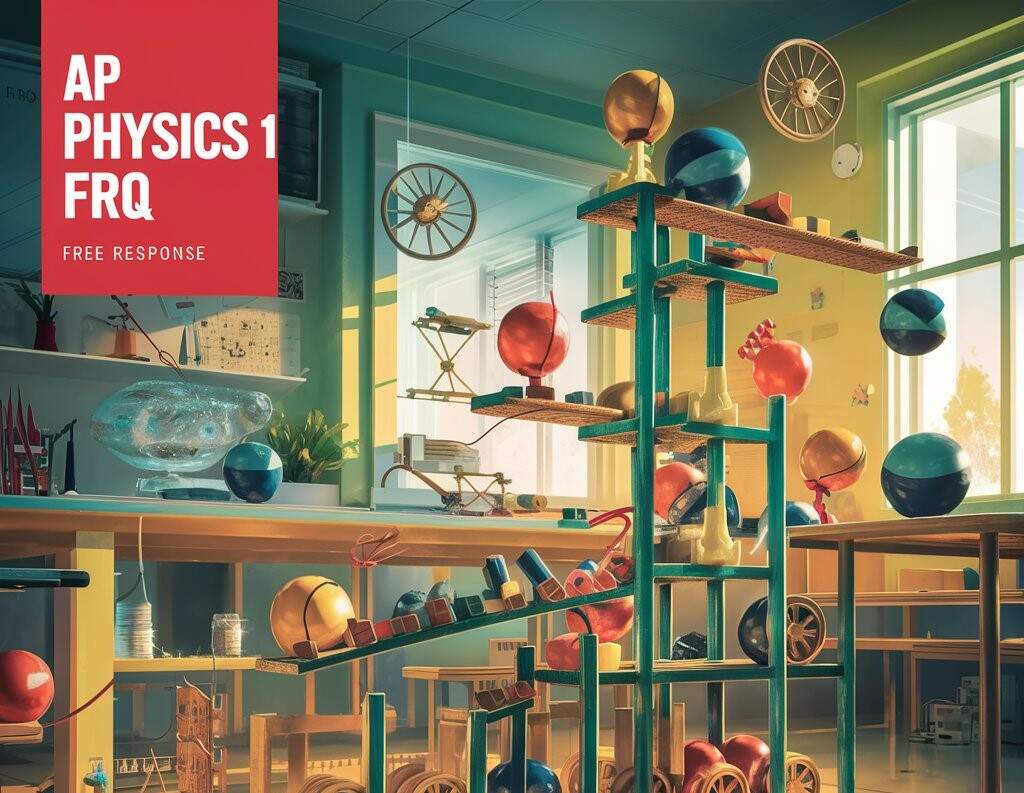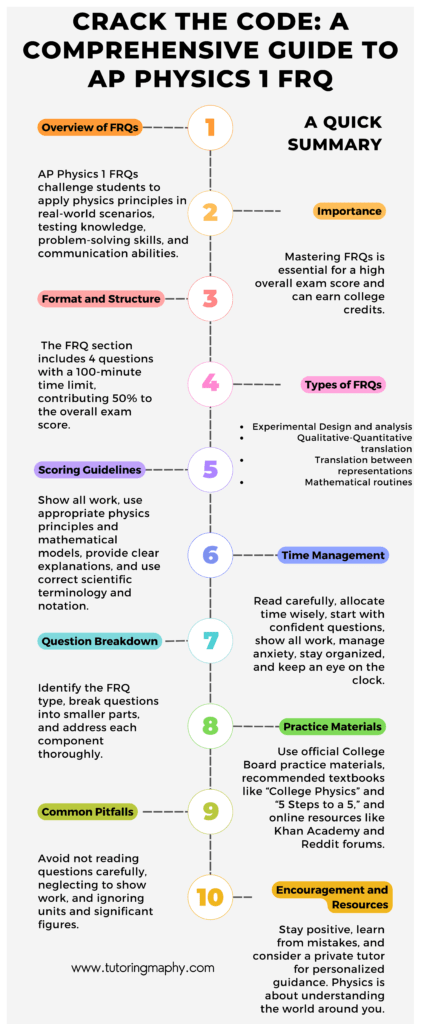I. Introduction
A. Brief overview of AP Physics 1 FRQs
AP Physics 1 Free Response Questions (FRQs) are a key component of the AP Physics 1 exam. These FRQs challenge students to apply their understanding of physics principles in real-world scenarios. Picture this: you’re given a scenario involving a bouncing ball in a moving car, and you’re asked to analyze its motion or calculate its velocity. Sounds daunting? Don’t worry, we’ve got you covered. These FRQs are designed to test not only your knowledge but also your problem-solving skills and ability to communicate your solutions effectively. So, get ready to tackle these physics puzzles head-on and show the examiners what you’re made of!
B. Importance of mastering FRQs for success in the AP Physics 1 exam
Mastering Free Response Questions (FRQs) in AP Physics 1 is essential for achieving success on the exam. These FRQs not only test your understanding of physics concepts but also your ability to apply them in various scenarios. By mastering FRQs, you develop problem-solving skills that are crucial not only for the exam but also for future academic and professional endeavors. Additionally, earning high scores on FRQs can significantly boost your overall AP Physics 1 exam score, potentially earning you college credits and demonstrating your proficiency in the subject. If you are interested to know more about credits, checkout How are AP and College credits related? So, don’t underestimate the importance of mastering FRQs.
II. Understanding AP Physics 1 FRQs
A. Overview of the format and structure of FRQs
The format and structure of Free Response Questions (FRQs) in AP Physics 1 follow a consistent pattern designed to assess students’ understanding of physics concepts and their ability to apply them in various contexts. It’s important to be aware of the recent changes in AP Physics 1 exam from 2025, time limit allotted for these questions and their contribution to your overall exam score. Typically, students have a total of 100 minutes to complete the FRQ section of the AP Physics 1 exam. This time constraint requires efficient time management skills to ensure that each question receives adequate attention and effort.
While multiple-choice questions make up a significant portion of the exam, comprising 50% of the total score, FRQs also carry substantial weight, constituting the remaining 50%. This underscores the significance of performing well on FRQs for achieving a high overall score in AP Physics 1.
Check this out to know the overview of AP Physics 1
Additionally, FRQs often require students to apply mathematical equations, diagrams, and graphs to support their explanations.
Here’s a table depicting this info in easily understandable manner.
| Aspect | Details |
| Number of FRQs | 4 |
| Time Limit for FRQ Section | 100 minutes |
| Contribution of FRQs to Overall Exam Score | 50% |
| Contribution of Multiple-Choice Questions | 50% |
| Importance of FRQ Performance for Overall Score | Performing well on FRQs is crucial for achieving a high overall score in AP Physics 1. |
B. Explanation of different types of FRQs
Different types of Free Response Questions (FRQs) in AP Physics 1 require students to demonstrate their understanding and application of physics concepts in diverse ways. These FRQs can be categorized into four types:
- Mathematical routines: The first free-response question on the AP Physics 1 Exam, known as the Mathematical Routines (MR) question, evaluates students’ skills in creating and applying mathematical models. Students must calculate or derive a physical quantity, create or use a representation, and justify their claims. The final part demands a coherent, organized analysis that uses evidence, references physical principles, and clearly explains the student’s reasoning.
- Translation between representations: The second free-response question on the AP Physics 1 Exam, the Translation Between Representations (TBR) question, asks students to create and compare graphical, verbal, and mathematical models of scenarios. For example, students might draw free-body diagrams and energy bar charts for a block on a spring and then explain how these representations relate to each other.
- Experimental design and analysis: The third free-response question on the AP Physics 1 Exam, the Experimental Design and Analysis (LAB) question, involves justifying data selection, planning data collection, linearizing, analyzing data, and addressing sources of error. Practicing these skills during the course aids in success on this question.
- Qualitative/quantitative translation: The fourth free-response question on the AP Physics 1 Exam, the Qualitative/Quantitative Translation (QQT) question, and the multiple-choice section evaluate the understanding of functional relationships. Students need to identify, manipulate, and predict values from these relationships and explain phenomena using evidence. Scaffolded instruction can help them grasp how changes in one variable affect others in an equation.
| Question Type | Description | Number of Questions | Points per Question |
| Mathematical routines | Creating and applying mathematical models, Coherent, organized analysis that uses evidence. | 1 | 10 |
| Translation between representations | Create and compare graphical, verbal, and mathematical models of scenarios. | 1 | 12 |
| Experimental design and analysis | Justifying data selection, planning data collection, linearizing, analyzing data, and addressing sources of error. | 1 | 10 |
| Qualitative/Quantitative translation | Identifying dependencies, predicting values, and explaining phenomena with evidence, benefiting from scaffolded instruction for better mathematical understanding. | 1 | 8 |
C. Importance of knowing the scoring guidelines
These guidelines outline the broad criteria used by examiners to evaluate and score student responses. They typically include specific requirements and expectations for each question, such as:
- Identifying relevant physics principles or concepts.
- Applying appropriate mathematical equations or models.
- Providing clear and logical explanations of reasoning and problem-solving processes.
- Showing all relevant work and calculations.
- Communicating responses effectively, including proper use of scientific terminology and notation.
It is important to understand the importance of showing steps and work in AP Physics 1 FRQs, even though the final answer is not reached. While reaching the correct answer is undoubtedly important, the process of problem-solving is equally valuable. By showing their work and detailing each step of their thought process, students demonstrate their understanding of physics concepts and their ability to apply them in a logical and methodical manner. This approach not only helps examiners assess the depth of a student’s understanding but also provides opportunities for partial credit, even if the final answer is incorrect.
III. Strategies for Tackling AP Physics 1 FRQs
A. Time management tips during the exam
Effective time management is essential for success on the AP Physics 1 FRQs. Here are some practical tips to help you make the most of your time during the exam:
- Read Carefully: Take the time to read each question carefully and understand what is being asked before diving into your response.
- Allocate Time Wisely: Review the entire exam and allocate time to each question based on its point value and complexity. Prioritize questions you feel most confident about, but be sure to leave enough time to attempt all questions.
- Start with What You Know: Begin with questions you feel most comfortable answering. This builds confidence and momentum, making it easier to tackle more challenging questions later on.
- Show Your Work: Remember to show all your work and steps, even if you’re unsure of the final answer. This not only demonstrates your thought process to the examiner but also increases your chances of earning partial credit.
- Manage Your Anxiety: Keep calm and focused throughout the exam. Take deep breaths, stay positive, and don’t let anxiety or frustration derail your concentration.
- Stay Organized: Keep your workspace neat and organized to avoid wasting time searching for materials or notes during the exam.
- Keep an Eye on the Clock: Regularly check the time to ensure you’re progressing through the exam at a steady pace. If you find yourself spending too much time on a single question, consider moving on and returning to it later if time allows.
- Using the AP Physics 1 equation sheet effectively: An equation sheet is provided with the exam having all important formulas. It is quite helpful. Check this out to know about this equation sheet in detail.
By implementing these time management strategies, you can navigate through the AP Physics 1 exam efficiently and effectively, maximizing your chances of success.
B. Breaking down the question prompts effectively
Consider identifying which type of Free Response Question (FRQ) it is based on the information provided earlier in the blog. For example, if you feel most confident in solving quantitative problems, start with those questions first. Once you’ve identified the type of FRQ and any specific instructions, break the question down into smaller, more manageable parts, focusing on one aspect at a time. This systematic approach allows you to tackle each part of the question effectively, ensuring that you address all necessary components and provide a thorough response.
C. Importance of showing all work and providing reasoning
Showing all work and providing reasoning are essential aspects of answering Free Response Questions (FRQs) on the AP Physics 1 exam. This practice not only demonstrates your understanding of the underlying physics concepts but also allows examiners to follow your thought process and reasoning. By showing your work, including any calculations, equations, or diagrams, you provide transparency and clarity to your responses. This not only helps you earn partial credit even if your final answer is incorrect but also allows you to identify and correct any errors along the way. This maximizes your chances of earning a higher score on the AP Physics 1 exam.
IV. Practice: Resources for AP Physics 1 FRQs
A. Review of official College Board practice materials
Reviewing official College Board practice materials is a key step in preparing for the AP Physics 1 exam. These materials are specifically designed to reflect the format and content of the actual exam, providing you with a clear understanding of what to expect. By working through practice questions and tests, you can familiarize yourself with the types of questions you’ll encounter, the way they are structured, and the scoring guidelines used by the examiners. This practice helps you identify areas where you need improvement and develop effective strategies for tackling different types of questions. Additionally, reviewing the explanations for correct and incorrect answers can deepen your understanding of the concepts and principles tested on the exam. Using official practice materials is one of the most effective ways to build confidence and ensure you are well-prepared for the AP Physics 1 exam.
B. Recommended textbooks and study guides with FRQ practice
Using the right textbooks and study guides can make a big difference in your AP Physics 1 exam preparation. Some highly recommended resources include “College Physics” by Knight, Jones, and Field, and “5 Steps to a 5: AP Physics 1″ by Greg Jacobs. These books cover the key concepts and provide plenty of practice problems, including Free Response Questions (FRQs). Another great resource is “Cracking the AP Physics 1 Exam” by The Princeton Review, which offers both content review and test-taking strategies. These books often include detailed explanations and solutions, helping you understand how to approach and solve FRQs effectively. By incorporating these recommended textbooks and study guides into your study routine, you can enhance your understanding of physics concepts and improve your skills in tackling FRQs, ultimately boosting your confidence and performance on the exam.
C. Online resources and forums for additional practice questions and discussions
Online resources and forums can be incredibly helpful for additional practice and discussions related to AP Physics 1. Websites like Khan Academy offer free video tutorials and practice questions that cover all the topics in the AP Physics 1 curriculum. For interactive discussions and tips, consider joining forums like Reddit’s r/APStudents or the College Confidential AP Physics 1 forum. These platforms allow you to connect with other students, share study tips, and get answers to specific questions. By utilizing these online resources and participating in forums, you can gain more practice, clarify doubts, and strengthen your understanding of the material, all of which are key to performing well on the exam.
V. Case Studies: Analyzing Sample AP Physics 1 FRQs
A. Walkthrough of sample FRQs with detailed explanations
Let’s see an FRQ from AP Physics 1 2023 exam.

This question is of 1 point. It can be briefly answered by using the Keyword “Energy conservation”. Here is the mark scheme:

Let’s see part b

This is a straight forward formula-based question. One can easily secure 2 points. Here is the mark scheme:

Part c (i) talks about qualitative answer for the shown graph.

By conceptually justifying the behavior, one could have secured 1 point. Here are sample responses:

The last one, c (ii) was slightly tricky but at the same time of 3 points. It is related to graphing.

Here is the point wise breakdown of answer:

B. Common pitfalls to avoid
When preparing for the AP Physics 1 exam, it’s important to be aware of common pitfalls that students often encounter.
- One common mistake is not reading the question carefully. Make sure you understand all parts of the question before you start answering.
- Another pitfall is neglecting to show all your work and reasoning. Even if you think the steps are obvious, writing them out can help you earn partial credit. Avoid rushing through the problems; take your time to think through each step.
- Additionally, don’t ignore units and significant figures in your answers. Incorrect or missing units can lead to losing points.
VI. Final words of encouragement and motivation for mastering AP Physics 1 FRQ
Mastering AP Physics 1 FRQs might seem challenging, but remember, every expert was once a beginner. Consistent practice and a clear understanding of the concepts will help you improve. Don’t get discouraged by mistakes; they are valuable learning opportunities. Stay focused, keep a positive attitude, and believe in your abilities. Your hard work will pay off, and you’ll find that each step forward, no matter how small, brings you closer to success. Remember, physics is not just about getting the right answer but about understanding the world around you.
If you feel stuck, a private tutor can make a huge difference. A tutor can provide personalized guidance, help you understand difficult concepts, and give you targeted practice on FRQs. Tutoring Maphy specializes in providing AP Physics 1 tutor. We offer one-on-one sessions tailored to your needs, ensuring you get the support you need to excel. With our experts help, you can boost your confidence and perform your best on the exam. Keep pushing forward, and you’ll do great!
FAQ
1. How many FRQs on AP Physics 1
As per the latest changes, From 2025 onwards there are 4 FRQs of different types
2. What is the time limit to answer FRQs on AP Physics 1
Students get 100 minutes to answer all 4 FRQs
3. How is AP Physics 1 FRQ graded
FRQs are graded in step-wise manner. Some of the important points are:
- Checking appropriate mathematical equations or models.
- Verifying clear and logical explanations of reasoning and problem-solving processes.
- Checking all relevant work and calculations.
- Verifying proper use of scientific terminology, notation and Units.
4. How to answer AP Physics 1 FRQ
Keep the following in mind while answering FRQs:
- Importance of showing all work and providing reasoning
- Breaking down the question prompts effectively
- Time management tips during the exam




